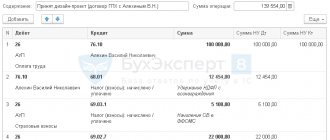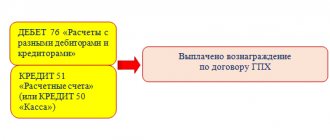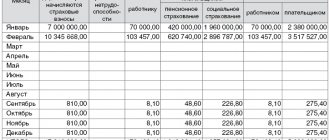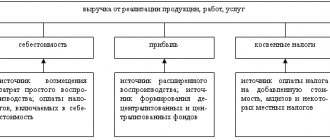Application of PBU 2/2008 in accounting
Accounting Regulations “Accounting for Construction Contracts” (PBU 2/2008), approved. by order of the Ministry of Finance of the Russian Federation dated October 24, 2008 No. 116n, applied since 2009.
Who should apply PBU 2/2008
PBU 2/2008 is used only by contractors under contracts related to construction, restoration (repair, modernization, reconstruction) or liquidation of real estate (buildings, structures, ships).
Small businesses may not apply the specified PBU if they make an appropriate entry about this in their accounting policies.
PBU 2/2008 applies to contracts that meet the following criteria:
1) by type of agreement:
— construction contract;
— agreement for the provision of services (contract) in the field of architecture, design, engineering surveys, etc.;
2) according to the terms of the contract:
— long-term contract (more than 1 year);
— the start and end dates of the contract fall on different years.
Accounting unit for accounting
The object of analytical accounting (accounting unit) on balance sheet accounts 20 and 90 is the contract. At the same time, p.p. 4-6 PBU 2/2008 establishes the following cases of separation, merger and division of executable contracts for the purpose of forming an accounting unit (accounting object):
1) one contract for a complex of objects is divided by object - each object is considered an agreement (for accounting) if the following conditions are simultaneously met:
a) technical documentation is available for each facility;
b) income and expenses are reliably determined for each object;
2) two or more contracts (with one or more customers) are combined into one contract (for accounting) if the following conditions are simultaneously met:
a) there is one project (with a rate of return for the project as a whole);
b) contracts are executed simultaneously or sequentially;
3) an additional construction project (additional work) is allocated as a separate contract if one of the conditions is met:
a) significant difference in design, technological or functional characteristics;
b) (or) the price is determined on the basis of an additional estimate agreed upon by the parties.
Income under the contract
Income under a construction contract is reflected as part of income from ordinary activities in accordance with PBU 9/99 (subaccount 90-1). In this case, sales revenue for each contract (Debit 62 Credit 90-1) is recognized taking into account the so-called “adjustments”. Adjustments include contract variances, claims, and incentive payments.
The procedure for determining sales revenue can be represented as a formula:
VD = CD + O + P + PP ,
where VD is revenue from sales under the contract; CD - contract price; O – deviations; P- claims; PP - incentive payments.
Deviations are changes in the cost of work agreed upon by the parties that may arise as a result of:
a) replacement of materials (cheaper or more expensive);
b) performing additional work not provided for in the technical documentation;
c) performing more complex work than provided for in the technical documentation;
d) exclusion (failure to perform) part of the work previously included in the scope of work under the contract.
Claims are demands that the contractor makes to the customer or other persons specified in the contract:
a) on reimbursement of costs that the contractor incurred due to the actions (inaction) of the customer or third parties;
b) compensation for reasonable expenses incurred by the contractor due to defects in the technical documentation;
c) on reimbursement of costs that the contractor incurred as a result of the customer’s failure to perform the functions provided for in the contract (providing connection points, power supply to the construction site, title temporary buildings and structures, etc.).
Incentive payments are amounts that are paid to the contractor additionally above the estimate when certain conditions specified in the contract are met (for example, for reducing construction time, etc.).
Note! Adjustments are included in revenue provided that they are provided for in the contract.
Claims and incentive payments are reflected when two conditions are met simultaneously:
1) there is confidence that the amounts will be recognized by the customer;
2) their amount can be reliably determined.
If at the reporting date there are doubts about the receipt of deviations, claims and incentive payments that were previously included in sales revenue, then they are recognized as expenses for ordinary activities of the reporting period. Revenue recognized in previous reporting periods is not adjusted!
Contract costs
They are recognized as expenses for ordinary activities in accordance with PBU 10/99 (balance sheet accounts 20, 25, 26).
The composition of expenses under the contract is determined by the following formula:
RD = PR + KR + P,
where RD – costs under the contract, PR – direct costs under the contract, KR – indirect costs under the contract, P – other costs under the contract.
Direct expenses under the contract are expenses that are directly related to the execution of the contract (are reflected in balance sheet account 20 “Main production”).
Please note that direct costs under the contract include anticipated costs.
Foreseen expenses are expected unavoidable expenses. They are included in direct expenses in the manner prescribed in the accounting policies:
1) as they arise;
2) (or) in the form of reserves to cover anticipated expenses.
Note! Foreseen expenses are recognized as direct expenses, provided that their reimbursement by the customer is expressly provided for in the contract, namely:
— types of anticipated expenses that the customer is willing to reimburse;
— procedure and conditions for compensation;
- the exact amount to be reimbursed.
PBU 2/2008 names the following types of anticipated expenses:
— elimination of deficiencies in projects or construction and installation works (for example, deficiencies in construction and installation work may be left by previous contractors or subcontractors);
— disassembly of equipment due to defects in anti-corrosion protection;
- expenses for warranty repairs and warranty service of the constructed facility (reservation of such expenses must be provided for in the estimate as a percentage of the estimated cost of construction and installation work, or included in the contract price).
Indirect costs under the contract are part of the organization’s total costs for the execution of construction contracts, attributable to a specific contract (recorded on balance sheet account 25 “General production expenses” and distributed at the end of the month according to the contracts being executed: Debit 20 Credit 25). The procedure for distributing indirect costs is established in the accounting policies. PBU 2/2008 offers one of the options for such distribution - using estimated norms and prices. Other options: in proportion to direct costs, or wages of main workers, or material costs for each contract in the total amount of corresponding costs for all contracts executed in a calendar month.
Other expenses under the contract are those general business expenses that, under the terms of the contract, are reimbursed by the customer (are reflected on balance sheet account 26 “General business expenses” and are debited to account 20 only by items and in the amounts provided for by a specific contract). Other expenses include separate expenses for managing a construction organization, conducting R&D, etc. Please note: reimbursement by the customer of other expenses must be specifically provided for in the contract.
The procedure set out in PBU 2/2008 for writing off other expenses under the contract (Debit 20 Credit 26) does not prevent the construction organization from establishing in its accounting policies a method for including general business expenses at the end of each month in full in the cost of sales (Debit 90-2 Credit 26). PBU 2/2008 deals only with specific types of expenses that are reimbursed by the customer under a specific contract and, therefore, these expenses are directly related to the receipt of income under such a contract.
A separate group includes expenses incurred before signing the contract (development of a feasibility study, preparation of an insurance contract for the risks of construction work, etc.). Such expenses are reflected as deferred expenses (in the debit of balance sheet account 97) and are written off in the following order:
1) in expenses under the contract (Dt 20 Kt 97) - if the contract was signed in the same reporting period in which the expenses were incurred;
2) as part of other expenses (Dt 91-2 Kt 97) - if the agreement was not signed in the reporting period.
Please note, “Other expenses under the contract” is a term introduced by PBU 2/2008. From the point of view of PBU 10/99, these are expenses for ordinary activities, which are reflected in balance sheet account 26.
In general, “Other expenses” are expenses that are not associated with normal activities. They are reflected in subaccount 91-2.
Income received from the execution of non-construction contracts
Such income includes:
1) income from the rental of construction machinery, equipment, formwork, construction sheds, etc.;
2) income from the sale of excess building materials, parts and structures;
3) other similar income.
In its accounting policies, the organization must choose a way to reflect such income:
1) accounted for as other income in subaccount 91-1 (Debit 62, 76 Credit 91-1);
2) (or) reduce direct expenses under the contract by the amount of income received (Debit 62, 76 Credit 20).
Determination of the financial result under the contract
The financial result under the contract (profit or loss) is determined by correlating the revenue under the contract and the expenses corresponding to this revenue. For this purpose, revenue and expenses are recognized in accounting using the “as ready” method, namely: based on the degree of completion of work under the contract as of the reporting date.
The method for determining the degree of completion of work under the contract is established in the accounting policies. PBU 2/2008 offers a choice of 2 methods:
1) by the share of the volume of work completed as of the reporting date in the total volume of work under the contract;
2) by the share of expenses incurred as of the reporting date in the estimated amount of total expenses under the contract.
In this case, both natural and cost indicators can be taken as the basis for determining the share. Thus, in the accounting policy you should not only choose a method for determining the degree of completion of work, but also prescribe an algorithm for applying the selected method.
Very important: the financial result of the reporting period is determined taking into account the revenue and expenses under the contract recognized in previous reporting periods under this contract.
Example
Using an example, we will consider the use of methods for determining the degree of completion of work in value terms.
Expected revenue under the contract is RUB 3,200,000.
Completed as of the reporting date – RUB 2,000,000, including:
— in previous reporting periods (revenue recognized) – RUB 1,200,000,
- in the current reporting period - 800,000 rubles.
Actual expenses as of the reporting date – RUB 1,500,000, including:
— in previous reporting periods – RUB 950,000,
- in the current reporting period - 550,000 rubles.
Costs according to the estimate, total – 2,700,000, including:
— for completed work – RUB 1,700,000,
- for the remaining work - 1,000,000 rubles.
The procedure for determining the degree of completion of work for different options is presented in Table 1, the algorithm for calculating the financial result is in Table 2.
Table 1
| By income (volumes completed in value terms) | By expenses |
| 2,000,000 / 3,200,000 x 100% = 62.5% | 1,500,000 : (1,500,000 + 1,000,000) x 100% = 60% |
table 2
| Index | By income | By expenses |
| Revenue, total | 2 000 000 (3,200,000 x 62.5%) | 1 920 000 (3,200,000 x 60%) |
| incl. revenue of the reporting period | 800 000 (2 000 000 – 1 200 000) | 720 000 (2 000 000 – 1 920 000) |
| Expenses, total | 1 562 500 (2,500,000 x 62.5%) | 1 500 000 (2,500,000 x 60%) |
| incl. reporting period | 612 500 (1 562 500 – 950 000) | 550 000 (1 500 000 – 950 000) |
| Financial result, total | 437 500 (2 000 000 – 1 562 500) | 420 000 (1 920 000 – 1 500 000) |
| incl. reporting period | 187 500 (800 000 – 612 500) | 170 000 (720 000 – 550 000) |
Conditions for using the “as ready” method
The “as ready” method is applied provided that the financial result under the contract as of the reporting date can be reliably determined.
The conditions for reliably determining the financial result are:
1) confidence in receiving economic benefits (income) from the contract;
2) the ability to identify and reliably determine expenses incurred under the contract.
PBU 2/2008 also establishes additional conditions for a contract with a fixed price (or a fixed price per unit of work) and with a mixed procedure for determining the price:
3) the ability to determine:
— the total amount of revenue under the contract;
— expenses necessary to complete the work under the contract;
— degree of completion of work as of the reporting date;
4) commensurability of the actual amount of expenses with previously made estimates of these expenses.
Method of equalizing revenue and expenses
The method of determining the financial result “revenue of the reporting period is equal to the expenses incurred in this reporting period” is applied only in the case when:
a) a reliable determination of the financial result in a given reporting period is impossible;
b) (i) there is confidence that the costs incurred will be reimbursed by the customer.
This method of determining the financial result can be used at the initial stage of execution of the contract, when its terms are clarified. When eliminating uncertainty, the “as ready” method is used (from the reporting period in which the uncertainty is eliminated).
If there is no certainty that the costs will be reimbursed by the customer, then only costs (without revenue) are recognized as expenses for ordinary activities of the reporting period (balance sheet account 20).
In cases where documented expenses are not reimbursed by the customer, the expected loss is recognized in the corresponding reporting period.
The expected loss is the identified (expected) excess of the amount of expenses over the amount of revenue under the contract.
Accrued revenue not presented for payment
Revenue under the contract, recognized using the “as ready” method, is accounted for until the work (stage) is fully completed as a separate asset - “accrued revenue not presented for payment.” This means that revenue should be reflected in accounting and reporting, regardless of whether the acceptance certificates for the work performed are drawn up or not. To reflect such revenue, you can use subaccount 46-2.
Accrued revenue not presented for payment is reflected in accounting by the following entries:
1. Before issuing an invoice for payment to the customer:
Debit 46-2 Credit 90-1 - revenue accrued under the agreement;
Debit 90-3 Credit 76, subaccount “Deferred VAT” - deferred VAT is calculated on revenue that has not been presented (the contractor does not have an obligation to pay VAT due to the absence of a work completion certificate);
2. When issuing interim invoices for payment to the customer:
Debit 62 Credit 46-2 - for the amount of revenue that is included in the invoice for payment;
3. Upon completion of the work and delivery of its results to the customer:
Debit 62 Credit 46-2 - for the amount of revenue that was not presented to the customer in invoices for payment;
Debit 76, subaccount “Deferred VAT” Credit 68, subaccount “Calculations with the budget for VAT” - deferred VAT is accrued for payment to the budget.
rule is established for the interim account : if the contract provides for incomplete payment of the invoice for work performed until certain conditions are met or deficiencies are eliminated, then such an amount is allocated in the interim account (clause 26 of PBU 2/2008).
Example
The beginning of the contract is December 2010, the end is January 2011. The work is handed over to the customer after complete completion (at the end of the contract).
The total cost of work under the contract is RUB 3,540,000, incl. VAT – 540,000 rub.
Costs according to the estimate – RUB 2,450,000, incl. The estimated cost of work in December is 1,000,000 rubles, in January – 1,450,000 rubles.
Actual expenses in December amounted to 870,000 rubles, in January – 1,400,000 rubles.
Revenue and expenses under the contract are determined using the “as ready” method. The degree of completion of work is determined by the share of expenses incurred as of the reporting date.
Degree of completion of work as of December 31, 2010: RUB 870,000. : (RUB 870,000 + RUB 1,450,000) x 100% = 37.5%
Revenue (including VAT) under the contract in December: RUB 3,540,000. x 37.5% = 1,327,500 rub. (including VAT – RUB 202,500).
For the accounting entries for this example, see Table 3.
Table 3
| Operation | Debit | Credit | Sum |
| December | |||
| Revenue accrued for December | 46-2 | 90-1 | 1 327 500 |
| Deferred VAT accrued on revenue | 90-3 | 76nds | 202 500 |
| The cost of work performed is reflected | 90-2 | 20 | 870 000 |
| January | |||
| Revenue accrued for January | 62 | 90-1 | 2 212 500 |
| Revenue not reported for payment is included in accounts receivable | 62 | 46-2 | 1 327 500 |
| VAT accrued for payment to the budget | 90-3 | 68-VAT | 337 500 |
| 76nds | 68-VAT | 202 500 | |
| The cost of work performed is reflected | 90-2 | 20 | 1 400 000 |
Accounting policy of a construction organization
The accounting policies of the contracting construction organization must disclose the following methods and methods of accounting in connection with the application of PBU 2/2008:
1) methods for distributing indirect costs between contracts (clause 13 of PBU 2/2008);
2) the procedure for reflecting anticipated expenses: as they arise or by creating a reserve. In cases of forming a reserve to cover anticipated expenses, the procedure for forming such a reserve (clause 12 of PBU 2/2008);
3) the procedure for reflecting income not related to the execution of construction contracts: as part of other income or for an increase in direct expenses (clause 12 of PBU 2/2008);
4) the method for determining the degree of completion of work under the contract (clause 20 of PBU 2/2008);
5) the procedure for using subaccount 46-2 (or other account/subaccount) to reflect “accrued revenue not presented for payment” and debt to customers (clauses 26, 29 PBU 2/2008);
6) the procedure for reflecting deferred VAT on revenue accrued but not presented for payment (76, subaccount “Deferred VAT”).
Accounting for construction contracts PBU 2/08
home >> economics textbooks >> Accounting Regulations (PBU) >> Accounting for construction contracts PBU 2/08
I. General provisions
1. This Regulation establishes the specifics of the procedure for the formation in accounting and disclosure in financial statements of information on income, expenses and financial results by organizations (with the exception of credit organizations and state (municipal) institutions) that are legal entities under the legislation of the Russian Federation and acting as contractors or as subcontractors (hereinafter referred to as organizations) in construction contracts (hereinafter referred to as contracts), the duration of which is more than one reporting year (long-term in nature) or the start and end dates of which fall on different reporting years. (as amended by Order of the Ministry of Finance of the Russian Federation dated October 25, 2010 N 132n)
2. This Regulation also applies to contracts for the provision of services in the field of architecture, engineering and technical design in construction and other services inextricably linked with the object under construction, for the performance of work on the restoration of buildings, structures, ships, on their liquidation (dismantling), including related with it, environmental restoration, the duration of which is more than one reporting year (long-term in nature) or the start and end dates of which fall on different reporting years. (as amended by Order of the Ministry of Finance of the Russian Federation dated April 23, 2009 N 35n)
2.1. This Regulation may not be applied by small businesses, with the exception of issuers of publicly offered securities. (clause 2.1 introduced by Order of the Ministry of Finance of the Russian Federation dated November 8, 2010 N 144n)
II. Accounting objects under contracts
3. Accounting for income, expenses and financial results is kept separately for each executed contract.
4. In the case where one contract provides for the construction of a complex of facilities for one or several customers under a single project, for accounting purposes the construction of each facility should be considered as a separate contract, subject to the following conditions being simultaneously met:
a) there is technical documentation for the construction of each facility; b) income and expenses can be reliably determined for each object.
5. Two or more contracts concluded by an organization with one or more customers must be considered for accounting purposes as one contract, subject to the following conditions being simultaneously met:
a) due to the relationship, individual contracts actually relate to a single project with a rate of profit determined as a whole for the contracts; b) contracts are executed simultaneously or sequentially (continuously following one another).
6. In the case when, during the execution of a contract, an additional construction project (additional work) is included in the technical documentation, for accounting purposes, the construction of an additional project (additional work) should be considered as a separate contract if at least one of the following conditions is met:
a) the additional object (additional work) differs significantly in structural, technological or functional characteristics from the objects provided for in the contract; b) the price of construction of an additional facility (additional work) is determined on the basis of an additional estimate agreed upon by the parties.
III. Recognition of income and expenses under the contract
7. Income under the contract is recognized by the organization as income from ordinary activities (hereinafter referred to as revenue under the contract) in accordance with the Accounting Regulations “Income of the Organization” PBU 9/99, approved by Order of the Ministry of Finance of the Russian Federation dated May 6, 1999 N 32n ( registered with the Ministry of Justice of the Russian Federation on May 31, 1999, registration N 1791). Taking into account the changes made by Orders of the Ministry of Finance of the Russian Federation dated December 30, 1999 N 107n, dated March 30, 2001 N 27n, dated September 18, 2006 N 116n, dated November 27, 2006 N 156n (registered with the Ministry of Justice Russian Federation: January 28, 2000, registration N 2064; May 4, 2001, registration N 2693; October 24, 2006, registration N 8397; December 28, 2006, registration N 8698).
8. The amount of revenue under the contract is determined based on the cost of work at the price specified in the contract, adjusted in cases and on the conditions provided for by the contract, in connection with:
- changes in the cost of work under the contract that arise during the execution of the contract by the agreed parties (hereinafter referred to as deviations), which are caused either by the use of higher quality and more expensive building materials and structures, as well as by the performance of work more complex than those provided for in the technical documentation or work not provided for in technical documentation (increase in revenue under the contract), or failure to perform any work provided for in the technical documentation (decrease in revenue under the contract);
- requirements (hereinafter referred to as claims) made by the organization to customers and other persons specified in the contract: for reimbursement of costs not included in the estimate that the organization was forced to incur in connection with the actions (inaction) of these persons; for reimbursement of reasonable expenses incurred in connection with the identification and elimination of defects in technical documentation provided by the customer or design organization (for example, in connection with the discovery of groundwater during construction), in connection with the delay or stoppage of work due to the customer’s failure to provide assistance to the organization , provided for by the terms of the contract (for example, for the transfer to the organization for use of buildings and structures necessary for the performance of work, provision of temporary connections for power supply networks, water supply), etc. (increase in revenue under the contract);
- amounts paid to the organization in addition to the estimate under the terms of the contract (hereinafter referred to as incentive payments), for example, for reducing construction time, etc. (increasing revenue under the contract).
9. Revenue under the contract is adjusted for the amounts of deviations, claims and incentive payments if there is confidence that such amounts will be recognized by customers or other persons specified in the contract to whom they are presented, and their amount can be reliably determined.
10. Expenses under the contract are recognized by the organization as expenses for ordinary activities in accordance with the Accounting Regulations “Expenses of the Organization” PBU 10/99, approved by Order of the Ministry of Finance of the Russian Federation dated May 6, 1999 N 33n (registered with the Ministry of Justice of the Russian Federation 31 May 1999, registration N 1790). Taking into account the changes made by Orders of the Ministry of Finance of the Russian Federation dated December 30, 1999 N 107n, dated March 30, 2001 N 27n, dated September 18, 2006 N 116n, dated November 27, 2006 N 156n (registered with the Ministry of Justice Russian Federation: January 28, 2000, registration N 2064; May 4, 2001, registration N 2693; October 24, 2006, registration N 8397; December 28, 2006, registration N 8698).
11. Expenses under the contract are those incurred by the organization for the period from the beginning of the contract to its completion:
- expenses related directly to the execution of the contract (direct expenses under the contract);
- part of the organization’s total expenses for the execution of contracts attributable to this contract (indirect costs under the contract);
- expenses not related to the construction activities of the organization, but reimbursed by the customer under the terms of the contract (other expenses under the contract).
12. Direct costs under the contract, in addition to those actually incurred, include expected unavoidable costs (hereinafter referred to as anticipated costs), reimbursed by the customer under the terms of the contract. Foreseen expenses are taken into account either as they arise during the construction process (to eliminate deficiencies in projects and construction and installation work, to dismantle equipment due to defects in anti-corrosion protection, etc.), or by creating a reserve for coverage anticipated expenses (for warranty service and warranty repairs of the created object, etc.).
A provision for covering anticipated expenses is established provided that such expenses can be reliably determined.
The organization's income not directly related to the execution of the contract, received during the execution of other types of contracts, is not included in the revenue under the contract and is taken into account as other income or included in the reduction of direct expenses under the contract. Such income includes, for example:
- income under a purchase and sale agreement from the organization’s sale of excess building materials and structures acquired for the execution of the agreement;
- income in the form of rent for construction machinery and equipment leased to other persons, which are temporarily not used for the execution of the contract.
13. Indirect costs under the contract are included in the costs for each contract by distributing the organization’s total expenses for the execution of contracts. Methods for distributing indirect costs between contracts are determined by the organization independently (for example, by calculations using estimated norms and prices that reflect the current level of production, technological and organizational standards in construction) and are applied systematically and consistently.
14. Other expenses under the contract may include certain types of expenses for the general management of the organization, for carrying out research and development work, and other expenses, the reimbursement of which by the customer is specifically provided for in the contract.
15. Costs associated directly with the preparation and signing of the contract (for the development of a feasibility study, preparation of an insurance contract for the risks of construction work, etc.) incurred by the organization before the date of its signing are included in the costs of the contract if they can be reliably are determined and if in the reporting period in which they arose, it is probable that the contract will be signed. If these conditions are not met, these expenses are recognized as other expenses for the period in which they are incurred.
16. Contract expenses are recognized in the reporting period in which they are incurred. In this case, expenses related to work performed under the contract are taken into account as production costs, and expenses incurred in connection with upcoming work are considered as deferred expenses. As revenue under the contract is recognized, contract expenses are written off to determine the financial result of the reporting period in the manner established by these Regulations.
IV. Recognition of financial results
17. Revenue under a contract and expenses under a contract are recognized on an “as-ready” basis if the financial result (profit or loss) of executing the contract as of the reporting date can be reliably determined.
The “as ready” method provides that revenue under the contract and expenses under the contract are determined based on the degree of completion of work under the contract confirmed by the organization as of the reporting date and are recognized in the income statement in the same reporting periods in which the relevant work was completed, regardless of whether they should or should not be presented to the customer for payment before the complete completion of the work under the contract (the stage of work provided for by the contract).
In the event that a reliable determination of the financial result of the execution of a contract in a certain reporting period is impossible, revenue under the contract is recognized in accordance with paragraph 23 of these Regulations.
18. Regardless of the procedure for determining the price of the work to be performed provided for in the contract, the necessary and sufficient conditions for reliably determining the financial result of the contract are:
- confidence that the organization will receive economic benefits associated with the contract;
- the ability to identify and reliably determine expenses incurred under the contract.
19. In the case where the contract provides for the payment by the customer of a fixed price for the performance of all work stipulated by the contract or a price determined on the basis of the price fixed in the contract for each unit of work performed (structure, type of work, etc.), in addition to those established in paragraph 18 of this The provisions of the necessary and sufficient conditions for reliable determination of the financial result of the execution of the contract are:
- the ability to reliably determine the total amount of revenue under the contract;
- the ability to identify and reliably determine the costs required to complete the work under the contract;
- the ability to determine the degree of completion of work under the contract at the reporting date;
- commensurability of the actual amount of expenses under the contract with previously made estimates of these expenses.
The rules of this paragraph also apply in cases where the contract provides for a mixed procedure for determining the price of the work to be performed (for example, as in a contract providing for reimbursement by the customer of all expenses incurred by the organization in connection with the performance of the work provided for in the contract, as well as payment of a percentage of these expenses simultaneously with agreed maximum price for the work to be performed).
20. To recognize revenue under a contract and expenses under a contract using the “as ready” method, an organization can use the following methods to determine the degree of completion of work under the contract as of the reporting date:
- by the share of the volume of work completed as of the reporting date in the total volume of work under the contract (for example, by expert assessment of the volume of work performed or by calculating the share of the volume of work performed in physical terms (in kilometers of roadway, cubic meters of concrete, etc.) in the total scope of work under the contract);
- by the share of expenses incurred as of the reporting date in the estimated value of total expenses under the contract (for example, by calculating the share of expenses incurred in physical and monetary terms in the estimated value of total expenses under the contract in the same meter).
21. When determining the degree of completion of work under the contract as of the reporting date by the share of expenses incurred as of the reporting date in the estimated total costs under the contract:
- Expenses incurred as of the reporting date are calculated only for work performed. Expenses incurred for future work under a contract (for example, the cost of materials supplied to perform the work but not yet used to perform the contract, rent paid in the accounting period but relating to future accounting periods), and advance payments to organizations performing as subcontractors under the contract, are not included in the amount of expenses incurred at the reporting date;
- The estimated total costs under the contract are calculated as the sum of all expenses actually incurred as of the reporting date and the estimated costs to be incurred to complete the work under the contract.
22. If at the reporting date the organization has doubts about the receipt of the amounts included in the revenue under the contract in accordance with paragraphs 8 and 9 of these Regulations (deviations, claims, incentive payments) and reflected in the profit and loss statement for previous reporting periods, then Amounts regarding the receipt of which there are doubts are recognized as expenses for ordinary activities of the reporting period. No adjustment is made to contract revenue recognized in previous reporting periods for these amounts.
23. In the event that a reliable determination of the financial result of the execution of the contract in a certain reporting period (for example, at the initial stage of execution of the contract, when the terms of the contract regarding the amount of expenses reimbursed by the customer are specified) is impossible, but there is a possibility that the expenses incurred during performance of the contract will be reimbursed, revenue under the contract is recognized in the income statement in an amount equal to the amount of expenses incurred that are considered recoverable during this reporting period.
Expenses for which there is no likelihood of reimbursement (for example, under contracts that may be recognized as invalid transactions or under which the parties cannot fulfill their contractual obligations) are recognized as expenses for ordinary activities of the reporting period.
If at the reporting date there is uncertainty in the possibility of receipt of all deviations, claims, incentive payments expected under the contract, then the amount that may not be received by the organization (expected loss) is recognized as expenses for ordinary activities of the reporting period (without reducing the amount of previously recognized revenue for agreement). In this case, the amount of the expected loss is recognized regardless of at what stage of the contract the expected loss arose. When uncertainty in the reliable determination of the financial result is eliminated, revenue under the contract and expenses under the contract are recognized in the manner prescribed by paragraphs 17 - 21 of these Regulations, regardless of at what stage of the contract the uncertainty is eliminated.
24. If documented costs under the contract are not reimbursed by the customer, the identified (expected) amount of excess of the costs under the contract over the amount of revenue under the contract (expected loss) is recognized in the corresponding reporting period.
25. When applying the “as ready” method in each reporting period, the determination of contract revenue, contract costs and financial results under the contract is made taking into account contract revenue and contract costs recognized in previous reporting periods under the specified contract.
26. In the accounting of an organization, revenue under a contract, recognized in the “as ready” method, is taken into account until the work (stage) is fully completed as a separate asset - “accrued revenue not presented for payment.”
If, in accordance with the contract, the organization can, during the execution of the contract, issue interim invoices to the customer for payment for work performed, accrued revenue for the work presented for payment is written off to accounts receivable as interim invoices are issued to the customer.
If the contract stipulates that part of the amount for work performed is not payable until certain conditions are met or until identified deficiencies in the work are eliminated, then such an amount should be allocated in a suspense account.
Accrued revenue not presented for payment is written off to accounts receivable when issuing an invoice to the customer for payment for completed work under the contract.
V. Disclosure of information in financial statements
27. The organization’s financial statements disclose the following information on contracts executed during the reporting period:
- the amount of contract revenue recognized in the reporting period;
- methods for determining contract revenue recognized in the reporting period.
28. The organization’s financial statements disclose the following information for each contract not completed as of the reporting date:
- the total amount of expenses incurred and profits recognized (less recognized losses) at the reporting date;
- the amount of received advance payment, advances, deposits as of the reporting date;
- the amount for work performed that is not presented to the customer until certain conditions are met or until identified deficiencies in the work are eliminated at the reporting date.
29. The difference between the amount of accrued revenue not presented for payment, which is recognized in the income statement for previous and/or current reporting periods, and the amount of accrued revenue on interim accounts presented for payment is reflected in detail in the organization’s balance sheet:
- as an asset - accrued revenue not presented for payment (if the difference is positive);
- as a liability - debt to customers (if the difference is negative).









